A recent comment by Marco Ponzi on Voynich Ninja helpfully highlighted a 2019 comment there by Linda which pretty much everyone else had overlooked. She had previously suggested visual parallels between the Voynich Manuscript’s drawings and the ones in Erlangen-Nürnberg, Universitätsbibliothek MS B7, but when Marco (and then Koen Gheuens too) looked a little further, they found some unusually strong matches.
In my opinion, the first excellent match is Marco’s bird:
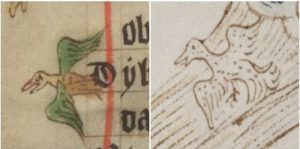
The second is Marco’s fish:
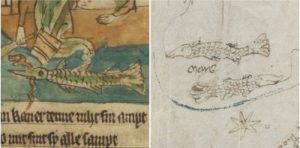
And the third is Koen’s child (from Heidelberg Cod. pal. germ. 330)
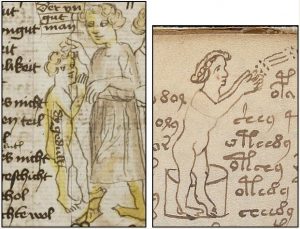
So what do we know about this manuscript?
A Welscher Gast mini-bibliography
The text of the Welscher Gast was written around 1215/1216 by Thomasin von Zerklaere (a cleric from Friuli), and is the first known code of conduct written in German. The ‘Italian Guest’ of the title is the Italian-speaking Thomasin himself, who apologizes for shortcomings in his German.
Given that numerous copies of the WG still survive today, it seems to have been a much-copied text. There is also, it has to be said, an ample secondary literature on the subject.
The great-granddaddy of this particular bibliographic tree was Heinrich Rückert, ed., Der walsche Gast des Thomasin von Zirclaria, Deutsche Neudrucke ; Reihe : Texte des Mittelalters (1852 ; rpt. Berlin : De Gruyter, 1965), which discussed twelve versions of the text.
This was then heartily supplanted by F. W. von Kries’ “Textkritische Studien zum Welschen Gast Thomasins von Zerclaere” in Quellen und Forschungen zur Sprach- und Kulturgeschichte der germanischen Volker, Neue Folge, 23 (147) (Berlin : De Gruyter, 1967), which expanded the study to twenty one mss, and included a partial stemma.
Books and articles since have discussed other WG mss and fragments unknown to Rückert and von Kries, such as those given the titles Si, F, and N. For more, you might check ARLIMA’s nice long list, though anyone thinking this is even 10% of the total set of WG articles is likely to be in for a bit of a shock.
Welscher Gast Manuscripts
For clickable links, the basic starting point here is the HandSchriftencensus Welscher Gast page, which lists twenty five manuscript copies.
Helpfully, Judith-A. Davidson’s “The Contamination of MS D of Der Welsche Gast” (Dresden, Sächs. Landesbibl. M 67), A Comparative Study of Text and Illustration Cycle, nicely lists these alongside their modern Sigles:
Parchment manuscripts
- A : Heidelberg, Universitätsbibl., Cod. pal. germ. 389.
- G : Gotha, Forschungsbibl., Membrana I 120.
- S : Stuttgart, Wùrttemberg. Landesbibl., Cod. poet. et philol. f. 1.
- E : New York, Pierpont Morgan Library, Glazier Ms. 54.
- H : East Berlin, Deutsche Staatsbibl., Hamilton Ms. 675.
Parchment fragments
- Gr : Formerly in Berlin, Preussische Staatsbibl., Ms. germ. 4° 978. (The MS, lost in 1945, was presumably destroyed by fire).
- Bü : Fürstliches Ysenburg-Büdingsch. Rentkammerarchiv.
- Pe : Budapest, National Szechenyi Library, Ms. Clmae 210 (formerly Cod. Misc. Hist. Hung, et Germ. Nr. 1559 f. lat). (The fragment was stolen, but had been published by R. M. Werner prior to the theft).
- Wo : Wolfenbüttel, Herzog-August-Bibl., 404 9 (6) Novi.
- Wa : Watzendorf bei Coburg, Evangelisches-Lutherisches Pfarramt.
- Erl : Erlangen, Universitätsbibl., Ms. B7.
- Ma : Berlin, Staatsbibl. Preussisch. Kulturbesitz, Ms. germ. f. 757.
- Si : Sibiu (Hermannstadt), Rumanian State Archive, GG 3/X Tomus A.
Paper manuscripts
- U : Munich, Bayerisch. Staatsbibl., Cgm 571.
- W : Wolfenbuttel, Herzog-August-Bibl., Ms. 37.19 Aug. 2°.
- a : Heidelberg, Universitätsbibl., Cod. pal. germ. 320.
- c : Heidelberg, Universitätsbibl., Cod. pal. germ. 338.
- K : Karlsruhe, Badisch. Landesbibl., St. Peter pap. 35.
- M : Munich, Bayerisch. Staatsbibl., Cgm 340.
- b : Heidelberg, Universitätsbibl., Cod. pal. germ. 330.
- D : Dresden, Sachs. Landesbibl., M. 67.
- N : Nürnberg, Germanisches Nationalmuseum, Hs. 86035.
- F : Stift Schlierbach, Hs. 28. (Grubmüller, who identified the MS., used the sigle « C »).
Paper fragment
- Tü : Berlin, Staatsbibl. Preussisch. Kulturbesitz, Ms. germ. 2° 718.
Note that, according to Davidson (who I heavily rely on in the following), “The thirteen illustrated MSS are A, G, S, E, H, Gr, Bu, Erl, U, W, a, b and D.”
Messy Stemmas
Given that we’re specifically interested in the illustrations in the 15th century ‘Erl’ copy, what we’d really like to see now is a nice neat Lachmannian stemma, to point us at related manuscripts (and to help bracket out all the 12th and 13th century copies that are unlikely to be of interest). And here’s the stemma that Davidson gives, adapted from von Kries’ stemma (she had access to all his photographs and collations):
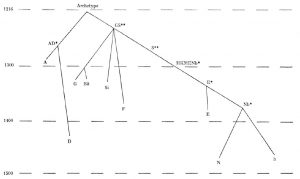
Yet I should caution that the whole reason for Davidson’s article is that there are problems taking too literal a view of the WG stemma. Her argument is that the D copy was “contaminated”, in that it suffers from “horizontal transmission” (von Kries also highlights that book 10 of H is similarly contaminated) between that original (left) half of the tree and the S** (right) half that branched off in the mid-13th century. Her modified sub-stemma looks like this, with an extra (lost) D* manuscript feeding in to D as well as the (lost) AD* copy:
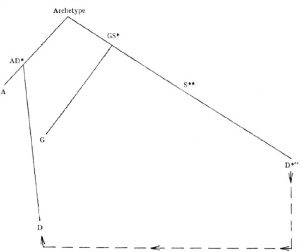
Davidson also argues that the earliest description of the WG illustration tradition by Adolf von Oechelhäuser, “Der Bilderkreis zum Walschen Gaste des Thomasin von Zerclaere” [Heidelberg : Gustav Koester, 1890] got quite a lot of important stuff wrong. Which is important because she thinks that the illustration contamination of D there parallels the textual contamination of D.
All the same, the two obviously later manuscripts on the right hand side half of the tree to consider are b and N:
- b : Heidelberg, Universitätsbibl., Cod. pal. germ. 330.
- N : Nürnberg, Germanisches Nationalmuseum, Hs. 86035. (which, annoyingly, has blank areas left for drawings that were never copied in)
Cod Pal germ 330 was made in Nordbayern (Eichstätt?) in 1420, according to the Universitätsbibliothek Heidelberg description. Here are its birds:

Incidentally, the Erlangen bird page in context looks like this:

Initial Thoughts
Anyone who thinks using stemmae for tracing illustrations are innately easy should have a look at the Welscher Gast. The Welscher Gast digital project has patiently catalogued all the illustrations across all the known manuscripts (though I must admit I found the ways they cross-linked things more than a little confusing at times). However, the illustrations vary so enormously that it’s often hard to see (if you discount all the easy pages, like Euclid etc) how X’s illustrations relate to Y’s illustrations.
My thoughts are therefore that the German scribal copy shops putting together all these copies had so many drawings to make that they, exactly like the Alsace scribes we have discussed before, simply copied whatever material they had at hand to get the job done. (And what a sadly banal phrase that has now become, *sigh*.)
So, whereas I went into the Welscher Gast world wondering if there might be some kind of scribal transmission of the images to pick up on, I now think that – for the very most part – the WG simply wasn’t that kind of a beast. That is, its diagrams weren’t implicitly interesting: rather, they were window-dressing the text, because this was a text-centric gig, not an illustration-centric one.
Hence I confidently predict that the bird, the fish and the child were all taken from other 1420s German manuscripts done in these and similar copy shops, and which were happily reused when these kinds of copying commissions came in. But the Welscher Gast was probably a recipient of these images, not a source.
Thanks for looking further into this, Nick.
One thing I don’t quite understand. Presumably the illuminated versions were all copied from each other, right? So if they had a version of the illustrations at hand, why should they hunt through other sources for a different example? Unless each of them thought their predecessor did a really poor job 🙂
Anyway, the bird for example is from an allegory about bad people bullying the virtuous man. It is clear that the VM bird, if copied from some now lost link of the WG stemma, is used in a different context. Also many of the WG images feel very distant from the VM, jousting knights for example. So if there is a connection, it’s more like cherry picking the required examples. Which the VM seems to have done from a variety of sources.
Interestingly, the similarities we pointed out are from exceptional VM images. The VM draws really ugly animals, but that bird is well done and can only be recognized as a bird. The child is exceptional in the VM since it’s one of the two or three figures in profile. It feels like it was painstakingly copied from a separate source. It’s as if the VM artist did not feel confident drawing certain poses and went looking for available examples.
When you look at the VM child, you can feel how difficult it was for them to copy this pose. I just noticed he has 11 fingers, three of which are thumbs 😀
Koen: for stemmae, we only ever have a badly incomplete ‘tree’ of manuscript copies, and less than half the WG copies we know about are illustrated.
Also, many of the entries in the tree are reconstructed (marked with a *) based on a shared textual divergence, and only in some cases are we able to tell whether or not these reconstructed copies were illustrated.
But the truly interesting thing about all this is that these drawings sit outside the zodiac roundel sequence, and we’ve never really had any kind of Art History way in to them before. It’s not perfect, sure, but it might well be a starting point.
Perhaps if we can identify the scribal workshops where these two mss were made, we might be able to generate a list of other illustrated mss by the same workshops to look more closely at.
K. Gheuens wrote: “It’s as if the VM artist did not feel confident drawing certain poses and went looking for available examples.”
I think that’s a good assessment.
If it couldn’t be drawn by formula (like most of the faces and poses), an exemplar was needed. If an exemplar wasn’t used (the illustrator possibly going by memory or imagination) the result was probably one of the vague drawings that we have trouble interpreting (e.g., the dragony critter).
Hmmmm…intriguing. A gar fish, but what’s it doing in a German MS from the 1200’s ? Their way of drawing some sort of Pike ? Wish I knew more Ichthyology.
This may be worth pursuing, I’ll just put aside, for now, my search for herbs that might help with respiratory infections, like the root of Lomatium Dissectum (a tip of the hat to the Washoe tribe of Nevada) and take a peek at this.
There’s lots of time, since the universe has come to a stop for several weeks.
Did I mention I’ve decided to not vacation in China ?
Thanks
James,
the fish in that example you’re discussing might have used the garfish as its model – I don’t wish to dispute that idea – but not those in the Vms.
And have you ever seen a picture of a clubfoot child? Is it a mythological or historical character or a text from Hippocrates?
@D
But….(caution, Ichthyology neophyte here), aren’t Gar fish native to North America and that Mss is from the 1200’s ?
And… how are we certain the fish in the VM are not Gar’s ?